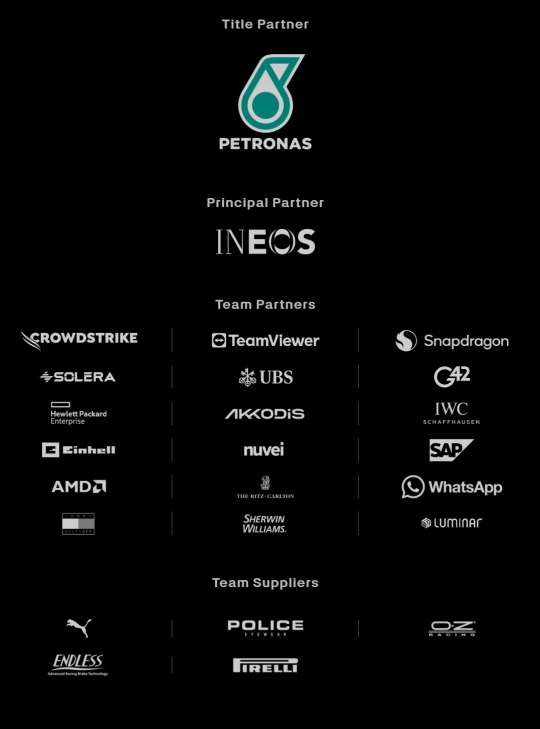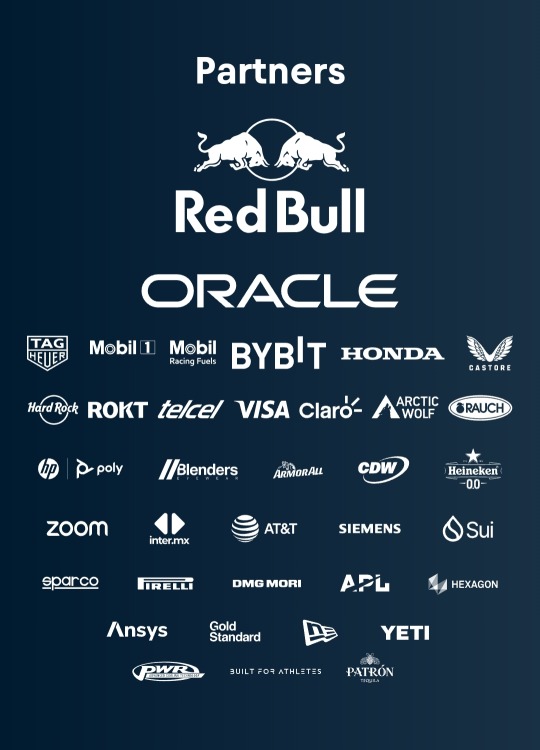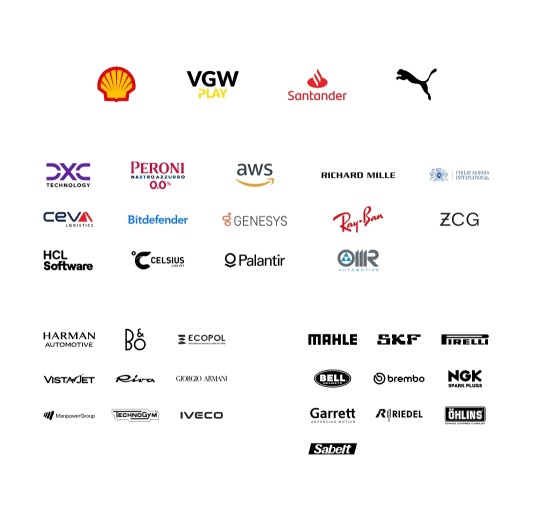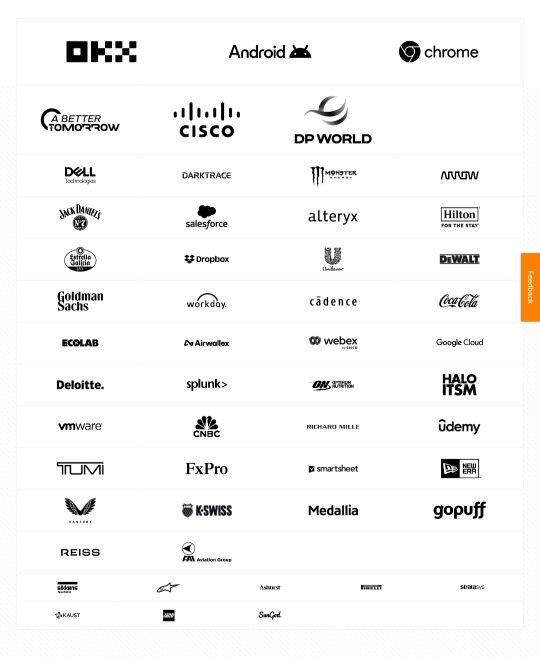#SAP Cloud Shipping Software
Explore tagged Tumblr posts
Text
Multi-Carrier Cloud Shipping Software Designed for all ERP Users
PIYOVI helps you digitally integrate to more than 100+ global carriers over 50+ countries and our primary focus is on empowering our customers to seamlessly integrate transportation processes into their existing IT landscape and warehouse infrastructure.
To know more about our shipping solution, visit our website and register for a personalized demo.

#shipping software#shipping solutions#logistics software#multi carrier shipping software#cloud shipping#shipping system#CloudTMS#shipping software solutions#SAP
1 note
·
View note
Text
2024 team sponsors recap!
this is completely irrelevant to F1 but i study and do these stuffs for a living sooo 😩😩 2023 sponsors are based on the sponsors that are there at the beginning of the season (new sponsors that join in the middle of the season will be classified as 2024's)
Mercedes AMG Petronas F1 Team:

New sponsors: Whatsapp, Luminar (American tech company), SAP (German software company), nuvei (Canadian credit card services), Sherwin Williams (American painting company) 2024 data last update: 2024/02/14
Old sponsors that left: Monster Energy, Pure Storage (American technology company), fastly (American cloud computing services), Axalta (American painting company), Eight sleep (American mattresses company) 2023 data last update: 2023/01/07
Oracle Red Bull Racing F1 Team:

New sponsors: Yeti (American cooler manufacturer, joined later in 2023), APL (American footwear/athletic apparel manufacturer, joined later in 2023), CDW (American IT company, joined later in 2023), Sui (American tech app by Mysten Labs, joined later in 2023), Patron Tequila (Mexican alcoholic beverages company, joined later in 2023) 2024 data last update: 2024/02/15
Old sponsors that left: CashApp, Walmart, Therabody (American wellness technology company), Ocean Bottle (Norwegian reusable bottle manufacturer), PokerStars (Costa Rican gambling site), Alpha Tauri (? no info if they're official partners or not but Austrian clothing company made by Red Bull), BMC (Switzerland bicycle/cycling manufacturer), Esso (American fuel company, subsidiary of ExxonMobil), Hewlett Packard Enterprise (American technology company) 2023 data last update: 2023/03/07
More: Esso is a subsidiary of Mobil so there's possibility they merged or something
Scuderia Ferrari:

New sponsors: VGW Play (Australian tech game company, joined later in 2023), DXC Technology (American IT company, joined later in 2023), Peroni (Italian brewing company), Z Capital Group/ZCG (American private asset management/merchant bank company), Celsius (Swedish energy drink manufacturer) 2024 data last update: 2024/02/15
Old sponsors that left: Mission Winnow (American content lab by Phillip Morris International aka Marlboro), Estrella Garcia (Spanish alcoholic beverages manufacturer), Frecciarossa (Italian high speed train company) 2023 data last update: 2023/02/16
More: Mission Winnow is a part of Phillip Morris International. They are no longer listed as team sponsor but PMI is listed instead.
(starting here, 2023 data last update is 2023/02/23 and 2024 data last update is 2024/02/15)
McLaren F1 Team: (Only McLaren RACING's data is available idk if some of these are XE/FE team partners but anw..)

New sponsors: Monster Energy, Salesforce (American cloud based software company, joined later in 2023), Estrella Garcia (Spanish alcoholic beverages manufacturer), Dropbox (American file hosting company), Workday (American system software company, joined later in 2023), Ecolab (American water purification/hygiene company), Airwallex (Australian financial tech company), Optimum Nutrition (American nutritional supplement manufacturer), Halo ITSM (American software company, joined later in 2023), Udemy (American educational tech company, joined later in 2023), New Era (American cap manufacturer, joined in 2023), K-Swiss (American shoes manufacturer, joined later in 2023), Alpinestars (Italian motorsports safety equipment manufacturer)
Old sponsors that left: DP World (Emirati logistics company), EasyPost (American shipping API company), Immersive Labs (UK cybersecurity training company?), Logitech, Mind (UK mental health charity), PartyCasino (UK? online casino site), PartyPoker (American? gambling site), Sparco (Italian auto part & accessory manufacturer), Tezos (Switzerland crypto company)
Aston Martin Aramco F1 Team:

New sponsors: Valvoline (American retail automotives service company, joined later in 2023), NexGen (Canadian sustainable? fuel company), Banco Master (Brazilian digital banking platform, joined later in 2023), ServiceNow (American software company, joined later in 2023), Regent Seven Seas Cruise, Wolfgang Puck (Austrian-American chef and restaurant owner, joined later in 2023), Financial Times (British business newspaper), OMP (Italian racing safety equipment manufacturer), stichd (Netherlands fashion & apparel manufacturer)
Old sponsors that left: Alpinestars (Italian motorsports safety equipment manufacturer), crypto.com (Singaporean cryptocurrency company), ebb3 (UK? software company), Pelmark (UK fashion and apparel manufacturer), Peroni (Italian brewing company), Porto Seguro (Brazilian insurance company), Socios (Malta's blockchain-based platform), XP (Brazilian investment company)
Stake F1 Team (prev. Alfa Romeo):
???? Can't found their website (might be geoblocked in my country???)
BWT Alpine F1 Team:

New sponsors: MNTN (American software company), H. Moser & Cie (Switzerland watch manufacturer), Amazon Music
Old sponsors that left: Bell & Ross (French watch company), Ecowatt (??? afaik French less-energy smthn smthn company), Elysium (French? American? Software company), KX (UK software company), Plug (American electrical equipment manufacturing company)
Visa CashApp RB F1 Team (prev. Scuderia Alpha Tauri):

New Sponsors: Visa, CashApp, Hugo Boss, Tudor, Neft Vodka (Austrian alcoholic beverages company), Piquadro (Italian luxury bag manufacturer)
Old sponsors that left: Buzz (?), Carl Friedrik (UK travel goods manufacturer), Flex Box (Hongkong? shipping containers manufacturer), GMG (Emirati global wellbeing company), RapidAPI (American API company)
Haas F1 Team:

New sponsors: New Era (American cap manufacturer, joined later in 2023)
Old sponsors that left: Hantec Markets (Hongkong capital markets company), OpenSea (American NFT/Crypto company)
Williams Racing:


New sponsors: Komatsu, MyProtein (British bodybuilding supplement), Kraken (American crypto company, joined later in 2023), VAST Data (American tech company), Ingenuity Commerce (UK e-commerce platform), Puma (joined later in 2023)
Old sponsors that left: Acronis (Swiss software company), Bremont (British watch manufacturer), Dtex Systems (American? cybersecurity company), Financial Times (British business newspaper), Jumeirah Hotels & Resorts, KX (UK software company), OMP (Italian racing safety equipment manufacturer), PPG (American painting manufacturer), Umbro (English sports equipment manufacturer), Zeiss (German opticals/optometrics manufacturing company)
#mercedes amg petronas#red bull racing#scuderia ferrari#visa cash app rb#haas f1 team#mclaren f1#aston martin#alpine f1#williams racing#stake f1 team#f1#ari's rant#sponsor talks
42 notes
·
View notes
Text
Warehouse Management System (WMS): The Backbone of Efficient Logistics
Managing a warehouse today isn’t just about stacking boxes and printing shipping labels. It’s about speed, precision, and visibility. That’s where a Warehouse Management System, or WMS, becomes a game-changer for businesses of all sizes.
If you're wondering how a WMS can transform your operations, you're in the right place.
What is a Warehouse Management System?
A Warehouse Management System (WMS) is a software solution that helps control and streamline all warehouse operations—from inventory tracking and order picking to receiving, packing, and shipping. In simple terms, it acts as the brain of your warehouse, ensuring everything runs efficiently and with fewer errors.
Why is WMS Important?
A warehouse without a WMS is like a city without traffic lights—chaotic and unpredictable. A good WMS helps:
Minimize picking and packing errors
Increase inventory visibility
Improve space utilization
Optimize workforce efficiency
Accelerate order fulfillment
These improvements aren’t just for show—they lead to better customer satisfaction, reduced costs, and higher profitability.
Key Features of a WMS
Today’s WMS platforms are built to handle complex workflows while being easy to use. Some core features include:
Real-time inventory updates
Barcode and RFID scanning
Automated replenishment alerts
Zone-based picking and wave picking
Returns and reverse logistics processing
Integrated shipping label generation
These tools give warehouse teams the ability to work faster and with far more accuracy.
Types of Warehouse Management Systems
There isn’t a one-size-fits-all when it comes to WMS. The four most common types include:
Standalone WMS – Installed locally and used exclusively for warehouse functions
Cloud-Based WMS – Hosted on the cloud, accessible from anywhere with internet
ERP-Integrated WMS – Embedded into enterprise software like SAP or Oracle
Supply Chain Execution Suites – Part of a larger supply chain management platform
Each has its strengths. Smaller businesses might favor cloud-based WMS tools, while large corporations may opt for robust ERP-integrated solutions.
How Does WMS Work Inside a Warehouse?
Here’s a simple walkthrough of how a WMS improves everyday operations:
A shipment arrives → WMS records incoming inventory
Goods are scanned and stored → WMS tracks their exact location
An order comes in → WMS tells workers the fastest way to pick it
Order is packed → WMS prints the shipping label and updates inventory
Item is shipped → WMS closes the transaction and logs the update
This seamless workflow drastically reduces manual errors and improves order cycle times.
Is SAP a WMS?
Yes. SAP offers a Warehouse Management module called SAP EWM (Extended Warehouse Management). It's a highly configurable system that supports complex warehouse processes, real-time tracking, and deep integration with SAP’s broader ERP and logistics tools.
What Are the Core Functions of a WMS?
A modern WMS typically handles:
Inventory tracking
Order fulfillment
Goods receiving and put-away
Picking and packing optimization
Labor and task management
Returns and restocking
Reporting and analytics
These functions help businesses stay competitive by creating faster, more accurate warehouse environments.
Benefits of Implementing a WMS
The return on investment for WMS software can be enormous. Here’s what businesses gain:
99%+ inventory accuracy
25–50% faster order processing
Reduced labor costs
Improved customer satisfaction
Greater warehouse transparency
Whether you manage one small storage facility or multiple distribution centers, a WMS can be scaled to fit your business model.
FAQs About WMS
🔹 What are the 4 types of WMS? Standalone, Cloud-Based, ERP-Integrated, and Supply Chain Execution Suites.
🔹 What is WMS in a warehouse? It’s the system that manages and automates key warehouse tasks—inventory, picking, packing, and shipping.
🔹 Is SAP a WMS system? Yes, SAP offers a warehouse solution called SAP EWM, designed for complex logistics operations.
🔹 What are the functions of WMS? Core functions include real-time inventory tracking, order fulfillment, returns processing, labor management, and analytics.
Final Thoughts
A Warehouse Management System is no longer a “nice-to-have”—it’s a “must-have” for businesses looking to scale efficiently and deliver consistently. In a world where customers expect next-day delivery and perfect accuracy, a robust WMS ensures your warehouse meets those expectations with ease.
If your business is growing and you’re still tracking inventory on spreadsheets, it might be time to level up with a smart WMS. It’s not just about keeping up—it’s about staying ahead.
#Warehouse Management System (WMS)#ERP-integrated solutions#Extended Warehouse Management#supply chain#supply chain management platform#ERP and logistics#SAP EWM#WMS
0 notes
Text
ERP Software Company in Kochi

Introduction
Kochi, the commercial capital of Kerala, is witnessing a surge in digital transformation across industries such as shipping, IT, tourism, manufacturing, and retail. One of the primary technologies accelerating this change is Enterprise Resource Planning (ERP). This blog explores the growing demand and offerings of ERP software companies in Kochi, the advantages they bring to various sectors, and how businesses can leverage SEO-optimized ERP development services for visibility and growth.
What is ERP Software?
ERP is a centralized business management solution that integrates various core functions—such as finance, human resources, inventory, production, and customer relationship management—into one seamless platform.
Core ERP Modules:
Financial Accounting
Inventory and Warehouse Management
Human Resource Management
Customer Relationship Management (CRM)
Manufacturing and Production Planning
Procurement and Supply Chain Management
Project Management
Business Intelligence & Reporting
Importance of ERP Software in Kochi's Business Landscape
1. Shipping and Logistics
ERP helps in managing fleet operations, cargo tracking, freight billing, and port logistics with real-time data accuracy.
2. Tourism and Hospitality
Enhances booking systems, inventory, guest experiences, HR, and payroll management in resorts and hotels.
3. Manufacturing Units
Supports production scheduling, raw material procurement, quality control, and equipment maintenance.
4. Retail and E-commerce
Provides centralized stock management, real-time sales analytics, and POS system integrations.
5. Healthcare Institutions
Streamlines patient record systems, billing, compliance, and hospital inventory management.
Benefits of ERP Software for Kochi-Based Enterprises
Enhanced Productivity
Centralized Information Access
Improved Financial Control
Efficient Resource Allocation
Regulatory Compliance and Reporting
Custom Dashboard and KPIs Monitoring
Remote and Mobile Access with Cloud ERP
Multi-language and Multi-currency Support
Top ERP Software Companies in Kochi
1. Infopark Solutions Pvt. Ltd.
Specialized in scalable ERP systems for manufacturing and export businesses.
2. KochiSoft ERP Developers
Offers modular and cloud-based ERP with CRM and HR integration.
3. Zerone Technologies
Known for robust and secure ERP software for financial institutions and logistics firms.
4. NavAlt Technologies
Focuses on maritime, marine, and industrial ERP customization.
5. Techno Globe ERP Solutions
Delivers enterprise-grade ERP with IoT, AI, and automation features for large organizations.
Custom ERP Development vs. Ready-Made Software
Feature Custom ERP Ready-Made ERP Personalization Fully customizable Limited customization Cost Higher initial investment Lower upfront cost Integration Seamless with existing tools May require APIs Scalability Highly scalable Depends on vendor Time to Deploy Longer Quicker setup
Technologies Used in ERP Development in Kochi
Languages: Python, Java, PHP, C#
Frameworks: Odoo, SAP, Oracle NetSuite, ASP.NET
Databases: PostgreSQL, MySQL, Oracle, MS SQL
Platforms: AWS, Azure, On-premise Servers
UI/UX: ReactJS, Angular, Bootstrap
Mobile: Flutter, Kotlin, Swift for mobile ERP apps
Industries That Benefit Most from ERP in Kochi
Maritime and Logistics Companies
Coir and Agro-Based Exporters
Rubber and Chemical Manufacturers
Multi-chain Retailers and Wholesalers
Educational Institutes and Universities
Ayurveda and Wellness Centers
Hospitals and Diagnostic Labs
Tourism and Hotel Groups
Future Trends in ERP Development in Kochi
AI-Driven Forecasting and Predictive Analytics
Blockchain in ERP for Transparent Supply Chains
IoT-Integrated Smart Manufacturing ERP
Chatbot Integration and Voice Commands
Augmented Reality (AR) for Real-time Data Visualization
Conclusion
ERP software companies in Kochi are playing a vital role in modernizing business operations, enhancing productivity, and delivering data-driven insights. From SMEs to large-scale industries, ERP adoption is no longer optional but essential. Custom ERP development tailored to local business needs is empowering Kochi-based enterprises to thrive in an increasingly competitive marketplace.
0 notes
Text
API Integration in Warehouse Management Software: What Matters to You
In this age of computer-based logistics and supply chain software, a WMS is no longer a single tool anymore. The contemporary business operates in interconnected ecosystems—integrated with ERP solutions, eCommerce storefronts, carriers for transportation, and accounting systems. To facilitate easy communication among diverse platforms, API integration matters.
So, what exactly is API integration, and how does it enhance the capabilities of a warehouse management system? Let's break it down with practical relevance.
What Is API Integration?
An API (Application Programming Interface) is a software intermediary that allows two programs to exchange data with each other. In the context of a warehouse management system, an API connects the WMS with other business systems like inventory systems, online stores, accounting packages, and logistics providers.
API integration minimizes the flow of data among systems to get rid of the need for manual input and potential errors.
Why API Integration is a Game-Changer for a Warehouse Management System
Below are some of the key reasons why API integration is a game-changer:
Real-time Data Synchronization
APIs allow your WMS to sync inventory, order status, and shipping details in real-time on every platform.
Operational Efficiency
API links eliminate redundant data entry and automate tedious processes, freeing up hours of manual labor.
Scalability
As your company grows, APIs allow you to incorporate new tools and services without the need to re-engineer your existing warehouse management system.
Customer Satisfaction
Correct, real-time tracking of inventory and orders directly affects order fulfillment speed and customer support.
Real-Time Instances of API Integration in Warehouse Management
Let's consider some real-life examples where API integration increases the efficiency of a warehouse.
1. Integration with eCommerce Platform
Scenario: An online sales platform for a warehouse is Shopify. When a customer orders something on Shopify, the WMS is notified immediately about the order information via API integration.
Stock information is updated in real-time.
The pick and pack team is auto-allocated the order.
Tracking details are pushed back to Shopify upon shipping.
It maintains correct inventory data on the site and increases delivery speed.
2. Shipping Carrier Integration
Example: FedEx and DHL APIs are linked to a WMS.
The WMS automatically retrieves the shipping label from the carrier once packed.
Real-time tracking numbers are assigned and updated in the WMS and customer portal.
Automatic tracking of delivery statuses.
This eliminates the necessity for logging into a number of different carrier portals and enhances logistics visibility.
3. ERP System Integration
Example: A manufacturing company employs SAP as its ERP and integrates it with a cloud-based warehouse management system.
Inventory information, raw materials, and finished goods are synchronized in the two systems.
Automated handling of purchase orders and invoices.
Inventories in the ERP mirror real-time warehouse activity.
This integration assists in consolidated reporting and intelligent procurement planning.
Typical APIs Installed with Warehouse Management Systems
A few typical categories of APIs installed with warehouse management systems are
Order Management APIs—installed to synchronize e-commerce site sales orders.
Inventory APIs—used for updating stock levels in real time across channels.
Shipping APIs—used to generate labels, track shipments, and determine rates.
Accounting APIs—used to send invoice and expense data to such platforms as QuickBooks or Zoho Books.
Supplier APIs—for monitoring vendor inventory or reordering automatically.
Selecting a WMS with API Capabilities
When you're selecting a warehouse management system, ensure it comes with secure and flexible API integration capabilities. Consider:
• RESTful API support
• Detailed documentation
• Alteration to suit your requirements
• Rapid real-time data synchronization
• Integration with third-party platforms you're already using
Some advanced warehouse management systems even come with pre-existing connectors with top platforms like Amazon, WooCommerce, Tally, or SAP.
Conclusion
API integration is no longer a choice—it's a must for companies that want to improve warehouse operations. An advanced warehouse management system with strong API support keeps you connected, automated, and responsive in today's changing supply chain era.
Through API integrations, firms are not just saving time and eliminating errors but gaining a competitive advantage in delivering quicker, more secure service. Whether your business is small online retail or a big logistics facility, an investment in a WMS with strong API functionality is a step in the direction of more intelligent, scalable warehousing.
0 notes
Text
NRS Infoways – Your Trusted API Integration Company in Dubai
In today’s fast-paced digital world, seamless data exchange and system interoperability are vital for business growth. That’s where NRS Infoways, a top-rated API Integration Company in Dubai, comes in. We specialize in empowering businesses with custom API integration services that streamline operations, enhance user experiences, and boost overall efficiency.
Why API Integration Matters
Application Programming Interfaces (APIs) are the building blocks of modern digital systems. They allow different software systems to communicate with one another, enabling businesses to automate processes, share data, and connect services effortlessly. Whether it’s payment gateways, CRMs, ERPs, social media platforms, or third-party tools — API integrations save time, reduce human error, and unlock new capabilities.
As a leading API Integration Company in Dubai, NRS Infoways understands the importance of reliable, secure, and scalable integrations tailored to your unique business needs.
What Sets NRS Infoways Apart?
At NRS Infoways, we believe that technology should work for you — not the other way around. Our experienced team of developers and system architects offers end-to-end API integration services that help businesses connect their applications with precision and ease. Here’s what makes us the go-to choice in Dubai:
1. Custom Integration Solutions
We don’t believe in one-size-fits-all. Every business has unique requirements, which is why our API integration services are fully customized to your workflows, systems, and goals.
2. Expertise Across Industries
From healthcare to finance, retail to logistics — we have successfully integrated complex APIs for clients in diverse industries. This wide-ranging experience enables us to understand your business challenges better and offer tailored solutions.
3. Secure and Scalable
Security is at the heart of everything we do. We ensure that your integrations are encrypted, authenticated, and follow the best security practices. Our solutions are also scalable, meaning they grow with your business.
4. Third-Party API Integration
Want to connect your system with Salesforce, Shopify, Stripe, or other third-party platforms? We’ve got you covered. We handle authentication, data mapping, and smooth implementation so you can focus on your core business.
5. Support & Maintenance
Our relationship doesn’t end with deployment. We offer ongoing support and maintenance to keep your integrations running smoothly and up-to-date with the latest changes.
Our API Integration Services Include:
Payment Gateway Integration (PayPal, Stripe, Razorpay, etc.)
CRM & ERP Integration (Zoho, Salesforce, SAP)
Social Media API Integration (Facebook, Instagram, LinkedIn)
Shipping & Logistics APIs
Custom Webhook Integration
Cloud Service Integration (AWS, Google Cloud, Microsoft Azure)
IoT API Integrations
Why Dubai Businesses Trust NRS Infoways
Dubai is a hub of innovation and business transformation. Companies here are always looking for ways to leverage technology to gain a competitive edge. NRS Infoways stands out as a dependable API Integration Company in Dubai due to our commitment to quality, transparency, and customer satisfaction.
We’ve helped startups, SMEs, and large enterprises integrate APIs that enhanced their productivity and user engagement. Our consultative approach ensures that your integration not only works but works for your business strategy.
Ready to Connect Your Systems Seamlessly?
If you’re searching for a reliable API Integration Company in Dubai, NRS Infoways is your ideal partner. Let us help you connect, automate, and grow with powerful API solutions that bring your digital ecosystem together.
Reach out to us today for a consultation and take the first step toward digital excellence with NRS Infoways.
0 notes
Text
Shipping Software Market Size, Share, Scope, Analysis, Forecast, Growth Opportunities, and Industry Report 2032
Shipping Software Market was valued at USD 13.01 billion in 2023 and is expected to reach USD 28.07 Billion by 2032, growing at a CAGR of 8.94% from 2024-2032.
The Shipping Software Market is witnessing significant growth as businesses increasingly adopt digital solutions to optimize logistics and streamline supply chains. The rise of e-commerce, demand for real-time tracking, and advancements in automation are driving this shift. Companies are leveraging shipping software to enhance efficiency, reduce costs, and improve customer experience.
The Shipping Software Market continues to expand as enterprises seek scalable and integrated solutions for managing shipping operations. With growing globalization and the need for faster deliveries, businesses are turning to cloud-based platforms, AI-driven logistics, and predictive analytics. This evolution is reshaping the industry, making shipping more agile, transparent, and cost-effective.
Get Sample Copy of This Report: https://www.snsinsider.com/sample-request/3892
Market Keyplayers:
SAP - SAP Integrated Business Planning (IBP)
Oracle - Oracle Transportation Management Cloud
BluJay Solutions - BluJay Global Trade Network (GTN)
Descartes Systems Group - Descartes Aljex
Manhattan Associates - Manhattan Transportation Management System (TMS)
Kewill - Kewill MOVE
ShipBob - ShipBob Fulfillment Software
CargoSmart - CargoSmart Shipping Management Solutions
FreightPOP - FreightPOP Shipping Software Platform
WiseTech Global - CargoWise One
Project44 - Project44 Supply Chain Visibility Platform
Transplace - Transplace Transportation Management System
Softeon - Softeon TMS
Cerasis - Cerasis Rater
3Gtms - 3Gtms Transportation Management System
Locus - Locus Route Optimization Software
ShipEngine - ShipEngine Shipping API
Easyship - Easyship Global Shipping Software
Onfleet - Onfleet Delivery Management Software
AfterShip - AfterShip Tracking API
Market Trends
AI and Automation – AI-powered route optimization, predictive analytics, and automated shipping processes are enhancing efficiency.
Cloud-Based Solutions – More companies are adopting SaaS (Software-as-a-Service) models to manage shipping operations remotely.
Multi-Carrier Integration – Businesses are using software that seamlessly connects multiple carriers to offer flexible shipping options.
Sustainability in Logistics – Green shipping initiatives, such as carbon tracking and eco-friendly packaging, are gaining traction.
Enquiry of This Report: https://www.snsinsider.com/enquiry/3892
Market Segmentation:
By Component
Software
eCommerce Shipping
Freight Management System
Multi-carrier Shipping System
Shipment Tracking
Shipping Label
Services
Professional
Managed
By Deployment
On-premise
Cloud
By Application
Retail & E-Commerce
3PL/Contract Logistics
Courier & Postal Services
Freight/Cargo Forwarding
Market Analysis
Rising E-Commerce Demand: The growth of online shopping is fueling the need for robust shipping solutions to handle increased order volumes.
Cost Efficiency & Speed: Companies are investing in software that minimizes shipping costs and optimizes delivery times.
Advanced Analytics: Predictive analytics and AI-driven insights are helping businesses forecast demand and manage inventory efficiently.
Regulatory Compliance: Shipping software is evolving to meet global trade regulations, ensuring smooth cross-border transactions.
Future Prospects
The future of the shipping software market is poised for further expansion, driven by:
Blockchain for Secure Transactions: Enhancing transparency and security in supply chain management.
Drones and Autonomous Vehicles: Transforming last-mile delivery with faster and cost-effective solutions.
5G and IoT Connectivity: Enabling real-time tracking and enhanced operational efficiency.
Customizable Software Solutions: Businesses demanding tailored features for their unique logistics needs.
Access Complete Report: https://www.snsinsider.com/reports/shipping-software-market-3892
Conclusion
The Shipping Software Market is evolving rapidly, with technology-driven solutions enhancing operational efficiency and customer satisfaction. As digital transformation accelerates, companies that invest in smart logistics software will gain a competitive advantage. The future holds exciting innovations, making shipping smarter, faster, and more sustainable.
About Us:
SNS Insider is one of the leading market research and consulting agencies that dominates the market research industry globally. Our company's aim is to give clients the knowledge they require in order to function in changing circumstances. In order to give you current, accurate market data, consumer insights, and opinions so that you can make decisions with confidence, we employ a variety of techniques, including surveys, video talks, and focus groups around the world.
Contact Us:
Jagney Dave - Vice President of Client Engagement
Phone: +1-315 636 4242 (US) | +44- 20 3290 5010 (UK)
#Shipping Software Market#Shipping Software Market Scope#Shipping Software Market Growth#Shipping Software Market Analysis
0 notes
Text
Top 13 warehouse Management Systems
Introduction
Warehouse Management Systems (WMS) are essential software solutions that optimize warehouse operations, enhance inventory management, and improve overall efficiency. These systems play a crucial role in modern supply chain management, enabling businesses to maintain accuracy and efficiency in a highly competitive landscape. By leveraging WMS, organizations can automate workflows, minimize human error, and enhance order fulfillment accuracy.
Overview of Top 13 Warehouse Management Systems
The following WMS platforms are recognized for their advanced features and functionalities, catering to diverse business needs by streamlining processes from inventory intake to shipping:
Oracle WMS Cloud – Uses AI and machine learning for advanced warehouse optimization, offering real-time inventory tracking and automated cycle counting.
SAP Extended Warehouse Management (EWM) – Provides comprehensive warehouse control with advanced automation, cross-docking, and integration with automated material flow systems.
Infor WMS – Features 3D visual warehousing, voice-enabled operations, and advanced slotting optimization for improved space utilization.
Manhattan WMS – Employs AI-driven inventory management and order processing, supporting multiple business channels.
Softeon WMS – A flexible platform supporting extensive warehouse functions, including workflow customization and seamless ERP integration.
Zebra Warehouse Management Solutions – Enhances operational efficiency through advanced data collection and management tools.
Fishbowl Warehouse – Popular among QuickBooks users for seamless accounting integration, real-time inventory updates, and shipping management.
Kechie Warehouse Management – Offers an integrated solution combining procurement, inventory, and financial management, supporting multi-warehouse operations.
mobe3 WMS – Scalable automation-driven system designed to streamline workflows and increase productivity.
3PL Central – A cloud-based WMS tailored for third-party logistics providers, ensuring efficient management of diverse operational challenges.
Zoho Inventory – Provides robust inventory tracking and order management, seamlessly integrating with the broader Zoho ecosystem.
Korber Warehouse Management Systems – Automates warehouse operations, enhancing scanning, shipping, and productivity.
Sage Enterprise Management – A flexible WMS offering comprehensive inventory management and integration with business management tools.
Key Features of Warehouse Management Systems
1. Integration Capabilities
A robust WMS should integrate seamlessly with other business-critical systems such as Enterprise Resource Planning (ERP) and Customer Relationship Management (CRM). Effective integration ensures enhanced data sharing, reduced manual data entry, and improved operational efficiency. For example, integrating WMS with ERP allows coordinated decision-making, leading to better inventory visibility and order processing.
2. Core Capabilities of WMS
The effectiveness of a WMS depends on its core functionalities, which optimize warehouse operations:
Warehouse Receiving: Ensures efficient processing of incoming goods with accurate inventory updates.
Inventory Tracking: Provides real-time inventory visibility, reducing stock discrepancies.
Order Fulfillment: Enhances picking accuracy and speed with automated workflows.
Returns Management: Facilitates seamless reverse logistics by integrating returned goods back into the inventory.
3. User Experience
User experience significantly impacts the efficiency and adoption of a WMS. Key considerations include:
Intuitiveness & Simplicity: A user-friendly interface with logical navigation reduces the learning curve.
Quality of User Guidance: Access to tooltips and help menus ensures users can effectively utilize features.
Adaptability: Systems should cater to varying levels of tech-savviness, enabling all employees to efficiently use the WMS.
Conclusion
Warehouse Management Systems have become indispensable in modern supply chain operations, providing solutions that cater to diverse business needs and operational complexities. The right WMS can improve efficiency, reduce errors, and enhance inventory accuracy, ultimately leading to better customer satisfaction. As technological advancements continue to reshape warehouse operations, selecting and implementing the appropriate WMS will be crucial in maintaining a competitive advantage.
0 notes
Text
Best Freight Management Software Solutions for Efficient Supply Chains

Introduction
In today's fast-paced logistics industry, managing freight efficiently is crucial for maintaining a smooth supply chain. Freight Management Software (FMS) helps businesses optimize shipping, reduce costs, and improve overall logistics operations. This blog explores the best freight management software solutions that enhance supply chain efficiency.
Why Freight Management Software is Essential
Freight management software streamlines the transportation process, from carrier selection to final delivery. The key benefits include:
Cost Reduction – Optimizes routes and minimizes fuel costs.
Real-Time Tracking – Enhances visibility and improves decision-making.
Automation – Reduces manual paperwork and errors.
Compliance Management – Ensures adherence to shipping regulations.
Data Analytics – Provides insights for better logistics planning.
trucking dispatch software
Top Freight Management Software Solutions
1. SAP Transportation Management
Comprehensive logistics planning and execution.
Real-time freight tracking and cost management.
Suitable for enterprises requiring end-to-end logistics control.
2. Oracle Transportation Management (OTM)
Scalable solution for global supply chains.
AI-powered analytics for demand forecasting.
Seamless integration with ERP systems.
3. FreightPOP
User-friendly cloud-based platform.
Multi-carrier shipping and automated rate comparison.
Ideal for small and medium-sized businesses.
4. Kuebix TMS
Free and premium versions for different business needs.
Advanced freight auditing and analytics.
Easy integration with existing supply chain systems.
freight management system
5. Descartes MacroPoint
Real-time shipment visibility and predictive analytics.
Automated alerts for supply chain disruptions.
Great for businesses focusing on proactive freight management.
How to Choose the Right Freight Management Software
Scalability – Choose a solution that grows with your business.
Integration – Ensure compatibility with existing ERP and logistics platforms.
Customization – Look for features tailored to your industry needs.
Support & Training – Opt for vendors with reliable customer support and training resources.
freight forwarding software
Conclusion
Investing in the right freight management software can significantly enhance supply chain efficiency, reduce costs, and improve customer satisfaction. Evaluate your business needs and choose a solution that aligns with your logistics goals for a more streamlined and effective shipping process.
0 notes
Text
An integrated multi-carrier shipping software provides significant benefits for SAP users, streamlining their shipping processes and enhancing operational efficiency. By seamlessly integrating with SAP, the software enables a seamless and automated shipping workflow, simplifying the entire shipping process from order creation to label generation and tracking. Here are the benefits and how the integration works
#SAP shipping software#multi carrier shipping software#shipping software#shipping solutions#logistics software#cloud shipping#Integrated SAP shipping software
1 note
·
View note
Text
Connected Logistics Market Poised for Significant Growth, Projected to Reach $73.4 Billion by 2033
The linked Connected logistics industry is expected to reach a valuation of $24.6 billion in 2023 and $73.4 billion in 2033. Over the projected period, connected logistics sales are expected to grow at an 11.5% CAGR.
IoT-enabled linked logistics solutions are expected to replace conventional transportation techniques, according to the connected logistics industry trend.Rising fuel prices and related environmental problems like pollution and carbon emissions shape the market trend.
The use of sensors, cloud computing, and automated procedures is common for the remote monitoring and management of supply chain operations. It also provides thorough comprehension of network issues, enabling quick and efficient decision-making.
Improved supply chain visibility leads to long-term cost savings, necessitating the use of IoT-enabled solutions in a variety of industries, including manufacturing, transportation, and automotive.
It is expected that the target market will benefit from the increased adoption of Logistics 4.0 and ongoing work on improving autonomous logistics trucks.
One of the factors fueling the market growth is the decreasing cost of loT sensors and connected logistics hardware. However, rising security and safety concerns in the logistics sector limit the market’s growth to some extent.
Key Takeaways:
Asset tracking is the top priority for the players which is leading the devices segment towards a strong growth of 12.5%. Organizations can collect massive amounts of data during the shipping and transit processes by incorporating RFID chips and IoT devices.
In terms of mode of transportation, roadways hold the majority of the market share and is showing a substantial growth of 12.2%. This is due to the increasing demand for road-based transportation to transport retail goods over long distances.
The usage of cutting-edge technologies like machine learning, the Internet of Things, cloud computing, big data, analytics, and deep learning is leading United States towards a revenue share of US$ 16.5 billion by 2033.
Rising public and private investment in the transportation sector is enhancing market expansion in the area is driving the United Kingdom regional market towards an impressive growth of 12.5%
Japan is the most lucrative region of all growing at an impressive rate of 15.7%. Japan began transforming logistics in order to strengthen its position in the Asia Pacific logistics industry by integrating new technologies with existing processes.
Manufacturers Eying Opportunities through Aggressive Strategies
The competitive landscape of this market is split moderately because of the presence of several developing and established companies in the industry. Moreover, it is forecasted that the technological developments in logistic sectors is anticipated to quicken the product development as well as investment growth.
In the market, there are different competitors aiming at addressing the problems aggressively by framing plans which are going to leave an overall impact on the market development. The growth prospects of this market have a lot of room to flourish during the forecast period.
Recent Development:
A top cloud-based logistics execution platform, BluJay Solutions was acquired by E2open Parent Holdings, Inc. for almost US$ 1.7 billion in May 2020. It is a foremost network-based provider of mission-critical, 100% cloud-based, and end-to-end supply chain management platforms.
Key Players:
AT&T Inc., IBM Corporation, Intel Corporation, SAP SE, Infosys Limited, Cisco Systems Inc., HCL Technologies Limited, Eurotech S.P.A., Microsoft, Oracle, Cloud Logistics, Zebra technologies, ORBCOMM, and GT Nexus.
Key Segments Covered in the Connected Logistics Market Report
By Component:
Connected Logistics Devices
Vehicle Telematics
Data Loggers
GPS Tracking Devices
RFID Tags
Connected Logistics Software
Fleet Management
Asset Tracking
Security Solutions
Connected Logistics Services
Consulting
Integration & Deployment
Support & Maintenance
By Transportation:
Connected Logistics for Roadways
Connected Logistics for Railways
Connected Logistics for Airways
Connected Logistics for Seaways
By Vertical:
Connected Logistics in Manufacturing
Connected Logistics in IT & Telecom
Connected Logistics in Automotive
Connected Logistics in Retail & Consumer Goods
Connected Logistics in Food & Beverages
Connected Logistics in Healthcare
Connected Logistics in Energy & Utilities
Others
By Region:
North America
Latin America
Western Europe
Eastern Europe
Asia Pacific excluding Japan (APEJ)
Japan
The Middle East & Africa (MEA)
0 notes
Text
Role of Advanced Technologies in Enhancing Logistics Education in Kochi
In the evolving field of logistics, embracing technological advancement is essential. Technology is reshaping how logistics is taught, understood, and applied, bringing new levels of efficiency, accuracy, and innovation to the industry. In a city like Kochi, where there is a growing demand for skilled logistics professionals, educational institutes are stepping up by integrating cutting-edge technologies into their curricula. These advancements are preparing students to become dynamic professionals ready to tackle the challenges of a modern logistics landscape. This blog explores the significant role of advanced technologies in enhancing logistics education in Kochi logistic institute in kochi
1. Digitalization and Cloud Computing in Logistics Learning
Digitalization and cloud computing are at the heart of modern logistics education. These technologies enable students to access course materials, collaborate with peers, and engage with instructors remotely, which is particularly advantageous in a bustling port city like Kochi. By digitizing logistics-related data, students can better understand the flow of goods, real-time inventory tracking, and warehouse management.
Cloud computing, in particular, has transformed how logistics data is stored, shared, and analyzed. With cloud-based tools, students and instructors can access simulations and analytics tools, providing a more hands-on experience. Platforms such as SAP, Oracle, and other logistics management software are used widely across the industry and are introduced in classroom settings, allowing students to familiarize themselves with real-world applications. This accessibility allows for deeper learning and prepares students for environments where such tools are regularly used, ensuring they can hit the ground running in their careers.
2. Artificial Intelligence and Machine Learning in Curriculum
Artificial intelligence (AI) and machine learning (ML) are not only improving logistics but also transforming how it’s taught. Educational institutions in Kochi are increasingly integrating AI and ML into their logistics curricula, recognizing that these technologies can optimize supply chains, forecast demand, and streamline operations. For students, understanding the principles of AI in logistics allows them to make data-driven decisions, manage complex logistics networks, and anticipate potential disruptions.
In the classroom, AI-powered analytics tools enable students to engage in predictive analysis, learning how to optimize routes, manage inventory levels, and improve operational efficiency. Machine learning models allow them to work with real-world datasets, gaining insights into cost-cutting and performance-boosting practices that they will later apply professionally. By grasping these advanced concepts, students gain a competitive edge, learning how to think critically and solve problems through AI and ML frameworks, both of which are invaluable in today's logistics sector.
3. The Role of IoT in Real-Time Logistics Training
The Internet of Things (IoT) is another technological revolution that is making waves in logistics education. IoT devices such as sensors, GPS trackers, and RFID tags play an essential role in tracking shipments, monitoring warehouse conditions, and ensuring the timely delivery of goods. In Kochi, where logistics students are gearing up for careers in a globally connected industry, IoT technologies are critical in their learning journey.
IoT-based simulations provide students with real-time insights into logistics operations. For example, they can see how data flows from sensors on shipping containers, enabling them to track temperature, humidity, and location. This real-world exposure prepares students to manage and interpret the constant influx of data typical in logistics, enhancing their analytical and decision-making skills. Additionally, these simulations allow students to visualize how IoT improves operational efficiency, minimizes losses, and ensures the integrity of goods from the point of origin to their final destination.
4. Blockchain Technology for Transparency and Security
Blockchain is making logistics more transparent and secure, qualities that are crucial in today’s interconnected global supply chains. Educational institutions in Kochi recognize blockchain’s importance in modern logistics and are incorporating it into their curricula. Blockchain’s decentralized nature ensures data security and transparency, reducing the risks of data tampering and increasing accountability.
For students, learning blockchain technology means understanding how to verify data integrity, track goods accurately, and minimize fraud in the supply chain. By engaging with blockchain simulations, students can practice verifying transactions, maintaining accurate records, and understanding supply chain transparency. These skills are increasingly relevant in the industry, where trust and accountability are critical, especially in sectors like pharmaceuticals and food logistics. Familiarity with blockchain gives students an edge in fields requiring high levels of security and compliance.
5. Augmented Reality (AR) and Virtual Reality (VR) in Training
Augmented Reality (AR) and Virtual Reality (VR) are changing how logistics training is conducted by creating immersive learning experiences. For instance, students can use VR to simulate warehouse operations, such as organizing shelves, tracking products, and managing workflows. AR and VR bring theoretical knowledge to life, allowing students to interact with and experience logistics processes firsthand without needing to be physically present in a warehouse or distribution center.
In Kochi’s logistics training programs, AR and VR offer an affordable way to practice logistics operations. Students can undergo training on warehouse management, shipment handling, and forklift operation in a virtual environment, honing their skills in a risk-free setting. AR and VR thus bridge the gap between theoretical knowledge and real-world application, ensuring that students are job-ready with practical experience by the time they graduate.
6. Big Data Analytics for Informed Decision-Making
Big data analytics is central to logistics, where it’s essential to make informed, timely decisions. Kochi's educational institutions emphasize big data analytics in their logistics programs, teaching students how to manage and analyze vast amounts of data from different parts of the supply chain. From understanding customer demand to optimizing transportation routes, big data enables more accurate forecasts and resource allocation.
Through hands-on projects, students can work with logistics data sets, allowing them to practice extracting insights and making data-driven decisions. This training helps them become proficient in using analytics software, which is commonly used in the logistics industry to improve efficiency, reduce costs, and enhance customer satisfaction. As big data continues to grow in importance, students trained in these skills will be well-prepared to meet industry needs.
7. Preparing Students for Industry Challenges
Integrating advanced technologies into logistics education in Kochi does more than teach technical skills; it also fosters adaptability and problem-solving capabilities. The logistics sector is highly dynamic, with frequent changes and new challenges. By exposing students to AI, IoT, blockchain, and big data, Kochi's institutions equip them with a diverse toolkit to handle these challenges. They develop analytical thinking, project management, and strategic planning skills that are vital in navigating the logistics industry's complex landscape.The role of advanced technologies in enhancing logistics education in Kochi is substantial. With a curriculum enriched by digitalization, AI, IoT, blockchain, and big data analytics, students gain hands-on experience that prepares them for a tech-driven logistics landscape. These advancements not only equip them with technical expertise but also with a forward-thinking approach essential for addressing future challenges in logistics. As these technologies continue to evolve, so will the quality and relevance of logistics education in Kochi, solidifying its role in producing skilled professionals ready to drive innovation in the global supply chain logistics courses in kochi
0 notes
Text
Trade Management Software Market is Anticipated to Witness High Growth Owing to Increased Cross-Border Trade Activity

Trade management software enables businesses to streamline the import and export trade processes, including customs management, global logistics and transportation management, trade compliance, trade finance and more. The software allows companies to digitally manage critical trade activities such as customs clearance, tariff and duty management, trade agreements, export controls and restrictions. It helps optimize trade operations, reduce costs and ensures compliance with global trade regulations. With the increasing globalization resulting in rising volumes of international trade transactions, there is a growing need for effective digital tools to efficiently manage complex cross-border trade activities. The Global Trade Management Software Market is estimated to be valued at US$ 5.06 Bn in 2024 and is expected to exhibit a CAGR of 10.% over the forecast period 2024 to 2031. Key Takeaways Key players operating in the Trade Management Software are Amber Road, Inc., Aptean, Descartes Systems Group, E2open, Expeditors International of Washington, Inc., Infor, Integration Point, Inc., International Business Machines Corporation (IBM), MIC Customs Solutions, Livingston International, Oracle Corporation, SAP SE, Schenker AG, Thomson Reuters Corporation, and Verizon Communications Inc. These players are focusing on developing innovative software and solutions and pursuing strategic partnerships and mergers & acquisitions to strengthen their market position. There is a significant opportunity for trade management software providers in optimized customs compliance, digitizing trade documentation, enabling single window connectivity and offering end-to-end visibility across extended supply chains. The market is also poised to grow owing to growing adoption of cloud-based solutions and increasing use of Artificial Intelligence and IoT technologies in trade and logistics operations. The Trade Management Software Market Demand is witnessing rapid global expansion driven by multinational companies scaling their international trade networks and trade corridors emerging across BRICS nations and developing economies in Asia Pacific and Middle East & Africa. Key players are enhancing their geographic footprints through partnerships and direct sales in high-growth regions. Market Drivers:
1) Growing cross-border e-commerce driving need for software to manage international sales and shipping.
2) Emerging trade agreements and changing trade policies increasing regulatory complexity for businesses focusing on global trade. Market Restraints:
1) High upfront costs and long implementation cycles of trade management software discouraging SMEs from adoption.
2) Integration challenges with legacy systems hindering seamless deployment of the software.
Segment Analysis The trade management software market is dominated by the trade compliance and logistics sub segment. This sub segment accounts for over 45% of the total market share as managing trade compliance and supply chain logistics have become extremely complex processes with ever evolving regulations and cross border documentation requirements. The trade compliance and logistics software helps organizations seamlessly manage compliance documentation, tariff schedules, import/export procedures, freight tracking and more across multiple geographic locations and trade partners. Global Analysis The North American region dominates the global trade management software market with over 30% share due to robust trade volumes between US, Canada and Mexico as well as stringent regulatory framework. The Asia Pacific region is witnessing the fastest growth and is expected to surpass North America to become the largest regional market during the forecast period. This is attributed to increasing globalization of business operations in countries like China, India, Japan and emergence of regional trade agreements between Asian economies.
Get more insights on Trade Management Software Market
About Author:
Money Singh is a seasoned content writer with over four years of experience in the market research sector. Her expertise spans various industries, including food and beverages, biotechnology, chemical and materials, defense and aerospace, consumer goods, etc. (https://www.linkedin.com/in/money-singh-590844163)
#Coherent Market Insights#Trade Management Software Market#Trade Management Software#Trading Platforms#Risk Management#Portfolio Management#Investment Software#Financial Technology
0 notes
Text
Boomi Application Connectors

Boomi Application Connectors: The Key to Streamlined Integration
In today’s interconnected world, businesses must constantly share data between applications and systems. This integration can be complex, time-consuming, and expensive, especially with various technologies and protocols. That’s where Boomi application connectors come to the rescue!
What are Boomi Application Connectors?
Boomi application connectors are pre-built integration components that simplify and accelerate connecting disparate applications. They provide a standardized way to interact with various applications, databases, and services, whether cloud-based or on-premises. Think of them as the bridges between your different software systems.
Why are Boomi Application Connectors Important?
Faster Integration: Boomi connectors eliminate the need for extensive custom coding and configuration. Their drag-and-drop interface lets you rapidly establish connections and data flows between systems.
Reduced Complexity: Connectors handle the intricacies of diverse protocols, data formats, and authentication mechanisms. They abstract the underlying technical details, allowing you to focus on your core business logic.
Enhanced Scalability: Boomi’s extensive library of connectors lets you easily add new applications to your integration landscape as your business needs evolve.
Improved Maintainability: Pre-built connectors with clear documentation help to maintain and manage your integrations without the overhead of bespoke codebases.
Types of Boomi Application Connectors
Boomi offers a wide range of connectors across various categories:
Technology Connectors: Connect to common protocols and technologies, such as HTTP, FTP, SOAP, JMS, databases, and more.
Cloud Application Connectors: Facilitate integration with popular cloud services like Salesforce, NetSuite, Workday, AWS, and others.
Packaged Application Connectors: Support specific business applications like SAP, Oracle E-Business Suite, and Microsoft Dynamics.
Industry-Specific Connectors: Cater to specialized needs in healthcare and finance (e.g., HL7, EDI connectors).
Boomi Application Connectors in Action
Let’s consider a few real-world use cases:
E-commerce Order Synchronization: A Boomi connector can seamlessly sync order data from your online store (e.g., Shopify) with your ERP system (e.g., NetSuite) and your shipping provider (e.g., FedEx). This automation ensures accurate and timely fulfillment.
Customer 360 View: Integrate data from your CRM (e.g., Salesforce), marketing automation platform (e.g., Marketo), and support desk software (e.g., Zendesk) to build a comprehensive understanding of customers.
Hybrid Cloud Integration: Establish secure data flows between your on-premises systems and cloud applications using Boomi’s robust connector library and hybrid deployment capabilities.
Beyond the Basics
The Boomi platform also empowers you to develop custom connectors using its software development kit (SDK). This comes in handy if you need to integrate with applications or systems that don’t have a pre-built connector.
Getting Started with Boomi Application Connectors
Visit the Boomi Connector Marketplace to explore the vast library of available connectors. The platform provides detailed documentation and tutorials to help you get started.
youtube
You can find more information about Dell Boomi in this Dell Boomi Link
Conclusion:
Unogeeks is the No.1 IT Training Institute for Dell Boomi Training. Anyone Disagree? Please drop in a comment
You can check out our other latest blogs on Dell Boomi here – Dell Boomi Blogs
You can check out our Best In Class Dell Boomi Details here – Dell Boomi Training
Follow & Connect with us:
———————————-
For Training inquiries:
Call/Whatsapp: +91 73960 33555
Mail us at: [email protected]
Our Website ➜ https://unogeeks.com
Follow us:
Instagram: https://www.instagram.com/unogeeks
Facebook: https://www.facebook.com/UnogeeksSoftwareTrainingInstitute
Twitter: https://twitter.com/unogeek
0 notes
Text
AMD EPYC CPUs boost SAP SD 2 Tier Performance

SAP Sales and Distribution (SAP SD)
4th Generation AMD EPYC processors are revolutionizing data center performance, power efficiency, and total cost of ownership through continuous innovation. This dual focus on performance and efficiency demonstrates AMD’s commitment to offering companies cutting-edge solutions for their data Centre needs.
At the moment, the extensive AMD EPYC ecosystem includes more than 800 different cloud instances and more than 250 different server designs. In more than 300 benchmarks, including business applications, technical computing data management, data analytics, digital services, media and entertainment, and infrastructure solutions, AMD EPYC processors have achieved performance records.
One of the most important logistics modules in SAP ERP (Enterprise Resource Planning) software is SAP Sales and Distribution (SAP SD). This module is essential to the management and archiving of vital business data among four main components:
Organisation Structure
By defining different units, divisions, and departments involved in the sales and distribution processes, SAP SD controls the organizational setup within the software.
Master Data
SAP SD stores material (product specs, inventory levels, and pricing) and customer (customer profiles, contact information, and transaction history) master data.
Business Processes
SAP SD manages all aspects of end-to-end , including order fulfilment, pricing, shipping, invoicing, and receiving payments. It guarantees the smooth execution and coordination of tasks linked to sales.
Reporting
With the help of SAP SD’s extensive reporting features, users can create intelligent analyses and reports using sales and distribution data. These reports offer insightful information on revenue generation, inventory management, customer trends, and sales performance.
All things considered, SAP SD is essential for improving productivity, simplifying sales and distribution processes, and facilitating well-informed decision-making in businesses using SAP ERP software.
The SAP-SD 2-Tier benchmark measures database performance in SAP Application Performance Standard units (SAPS) to assess hardware performance. Within the SAP environment, SAPS is a hardware-independent unit that measures system performance. The Sales and Distribution (SD) benchmark is the source of SAPS, which indicate how well a system can manage SAP workloads.
Vendors use their standard methodology to assess the system’s ability to support SD users during SAP benchmark testing. Every benchmark module has a weight that transforms users into a Normalised SD (NSD) number. NSD is used to calculate SAPS. SAP customers can size their SAP systems and plan their infrastructure footprint with the aid of SAPS results from the SAP SD benchmark. Customers can use this benchmark to compare platforms, plan for future growth, and perform Proof-of-Concepts (POCs) in order to choose the best hardware configuration for their SAP solution.
Regarding Bare Metal
Because SAP SD workloads are compute-intensive, 4th Gen AMD EPYC processors (9004 series) are the best option for bare metal server deployment of SAP applications. In comparison to previous-generation AMD EPYC processors, these processors maximise performance by utilising notable improvements in Instructions per Cycle (IPC), faster memory access, larger L3 cache sizes, and higher core density.
The performance gains achieved with “top of stack” processor SKUs over the course of the four generations of AMD EPYC general-purpose processors are shown in Figure 1. It also emphasises how consistently better 2nd generation AMD EPYC processors and subsequent generations are than equivalent generations of Intel Xeon processors. It is noteworthy that 5th generation Intel Xeon processors perform 53% worse than 4th generation AMD EPYC processors.
Within the Cloud
Do you want to use SAP in the cloud? Additionally, AMD EPYC processors provide extensive support in this area. Significant performance improvements across 2nd, 3rd, and 4th Gen AMD EPYC processors on Microsoft Azure and Amazon EC2 cloud instances are shown on the left side of Figure 2.On the right side of Figure 2, an Amazon EC2 m7a.48xlarge instance with 4th Gen AMD EPYC processors outperforms one with Intel Xeon Platinum 8488C processors.
SAP-SD Performance Analysis (Curiosity Analysis) Compared to SPEC CPU 2017
Many people make an effort to explain how the SPEC CPU 2017 benchmark accurately reflects enterprise applications found in the real world. Because of the extensive stress that its performance measurements place on a system’s processor, memory subsystem, and compiler, the SPEC CPU 2017 benchmark enjoys considerable industry prominence. Users can effectively compare the performance of different systems thanks to these measurements. While SPECspeed metrics track task completion time, SPECrate metrics track work completed per unit of time.
SAP SD 2 Tier
Of these metrics, Figure 3 shows that SPECrate 2017 Integer has a strong correlation with the SAP-SD 2-Tier Benchmark Users metric. Because it enables the derivation of trustworthy estimates for SAP-SD 2-Tier Benchmark Users based on the SPECrate 2017 Integer metric results published for each EPYC SKU, this correlation is especially valuable for SAP SD 2-Tier sizing.
In summary
The SAP SD benchmark results highlight AMD EPYC processors’ exceptional performance in the cloud and on bare metal. Cutting-edge technologies are supported by AMD EPYC processors from the 4th generation, such as “Zen 4” cores based on 5nm process technology, up to 12 DDR5 memory channels supporting up to 4800GHz in memory speed support, and up to 128 (1P) or 160 (2P) PCIe Gen5 lanes that offer twice the PCIe Gen4 transfer rate.
While AMD Infinity Guard technology improves data security while in use, the 3rd generation Infinity Fabric doubles the data transfer rate of the 2nd generation Infinity Fabric.[5] The lineup of 4th Gen AMD EPYC processors is further expanded by the AMD EPYC 97×4 and AMD EPYC 9004 processors with AMD 3D V-Cache technology, which are optimised models for memory-bound workloads and cloud infrastructure, respectively.
Read more on Govindhtech.com
1 note
·
View note